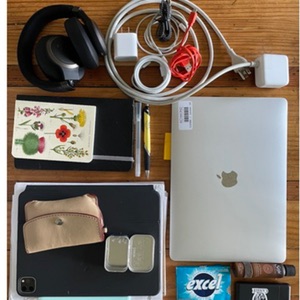When considering the translation of an image over that of sound, one must consider the translation of technologies. Some images are simple to identify in that the items are universally recognizable through sound. Additionally, what code is used to translate the articles? Are the consumers familiar with the chosen literacy? How are objects contextualized? What literacies are accessed to do so?
When considering the categorization used by The New London Group, in their article, A Pedagogy of Multiliteracies: Designing Social Futures, one might consider the audio design (whether to use music or sound effects), Spatial Design (how the items are used in specific spaces), and how the literacies are interconnected.
Soundscapes enable a different kind of semiotic capture. How might we hear electricity? Or the sound of fresh air to represent gum. What song do I hear when I see the wildflower journal?
Rethinking What’s in My Bag through the lens of sound deepens my sense of meaning-making. I connected items to words and then searched sounds for those words through my browser. I had never considered the sound of electricity or the shifting of a hand along paper when writing. There are nuances and possibilities in how these items are seen, and changing of the prescribed literacy allows those affordances to be more transparent.
Press the link to hear my Bag Soundscape: https://youtu.be/37MwF5oJlDE

Futures, D. S. (1996). A pedagogy of multiliteracies: Designing social futures. Harvard Educational Review, 66(1).
Hello Ellen,
It was interesting to hear how you interpreted the various items, and fun for me to try to identify what the sounds were and what they were connected to. I seem to be a more literal person as I was anticipating the gum to be the sound of the wrapper crinkling with the pop of the gum piece being dislodged or the sound of chewing.
It would be an interesting activity to show an entire class the same image, such as the contents of a backpack, and then ask them all to create soundscapes to observe the differences in interpretation and representation.
I love the approach you took for this task! I had thought about recording mini “soundbytes” and making a compilation of the sounds for this task, but had trouble with the low sound resolution and white noise in my background. I also couldn’t decide how I wanted to distinguish the “borders” between the sounds so that the listener knows that it is a new object. Yours is so crisp and clean, which I really appreciate, as it creates this immersive, 3-D environment for the listener. For the full experience, I would probably recommend others to listen to your soundscape video with earphones.
I was impressed by the less apparent qualities of each item that you were able to capture with sound. It seemed like you were telling a story with these sounds, which also made me reevaluate my own sense of meaning making, since not all of your sounds were literal.
I really love how you said, “Soundscapes enable a different kind of semiotic capture. How might we hear electricity? Or the sound of fresh air to represent gum. What song do I hear when I see the wildflower journal?” This perfectly embodies the spirit of your creation!
I enjoyed the creative spin and alternate perspective that was displayed with some of the segments, especially from items that could have been easier to show with their more explicitly representative sounds. It was fun to discover them as I go, and to think about what type of object emitted the sound based on my previous knowledge of an object’s physical characteristics and abilities.
Thank you so much for sharing your insight!